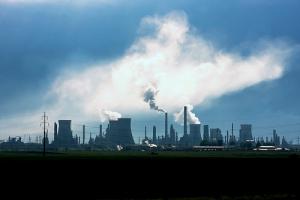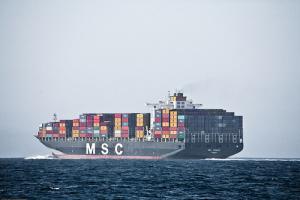
Crafting energy policy is a challenging balancing act. Even with the global and grassroots organizations across the globe pushing for cleaner fuels, bio-based fuels, and renewable energy. there are political, economic, environmental, and cultural realities that must be addressed. While leadership and a push for the future need to be provided, policy can't over-reach or there will not be enough general support (through the public or industry) and implementation will be difficult. If a policy is too much rooted in the status quo, then little will change or improve. I recently read a couple of stories that exemplified some of the diverse challenges and influences of this task.
Good intentions, but with what results?
The International Maritime Organization, which is the U.N. shipping agency, has set a 2020 deadline to reduce the sulfur content of fuels used in the global fleet while at sea. The current industry standard, commonly called bunker fuel, is mainly cheaper residual fuel oil that remains at the "bottom of the barrel" after all the more profitable fuels have been separated.
The current average sulfur content of bunker fuel is 2.7 percent, with the new 2020 standard set at 0.5 percent. By comparison, the typical limit for sulfur in gasoline in the US is 30 parts per million (ppm), or 0.0003 percent. It is estimated that seaborne trade accounts for less than 10 percent of global sulfur emissions from approximately 200 million tons of bunker fuel. But to replace this fuel by the most direct route is to move upstream and use cleaner fuels, such as the middle distillates used for other transportation, including airplanes, automobiles, and power plants. This would add even more demand to a series of products already seeing tremendous growth as demand for cleaner vehicles increases.

Estimates are that for all the bunker fuel demand to be replaced from these middle distillates, the global refining industry would require an investment of $150 billion. Some refiners are making the investment, but far from the industry-wide investment that would be required to meet the projected demand.
The conundrum now is how would the shippers meet this goal if there are not enough refiners producing cleaner fuel? What kind of incentives could be offered to the refiners to make this enormous investment for a low-profitability fuel? There is likely no single solution, as seems to be the case for many energy solutions. Exhaust scrubbing technology has been proposed, but again the cost of investment and timeliness of implementation are significant hurdles, though this would shift the cost of investment from the refiners to shippers. Alternative fuels, such as liquefied natural gas or biofuels, could help improve availability, plus the work required to retrofit the ships make this a small part of the solution. When the fuel of choice is selected by lowest price (as is the case with many "dirty" fuels), the economics present some difficult choices.
How far should the government go?
In another story, economics and other conditions drive the conversation in a different direction. The government in Seoul, South Korea, mandated, as of January 24, a maximum temperature of approximately 68 degree Fahrenheit for buildings and stores with large energy consumption. There are many factors in Korea that have a multiplier effect in encouraging conservative energy use. The city has been experiencing an unusually cold winter, pushing demand on the electrical grid to the upper limit of its capacity. Given that oil prices have recently risen and that Korea imports almost all its energy, energy is a significant concern on the peninsula.

There are also other conservation polices in place, such as requiring that many electronic stores turn off most of their display TVs. The government also has plans to replace incandescent light bulbs in traditional markets with LED lights. To address gasoline demand, the government will be increasing subway line frequency by 1 to 3 minutes from 10AM to 12PM.
The thermostat policy is actually a revision of a successful policy from the summer, when air conditioning use was pushing demand on the grid. A minimum temperature was set at the same selection of buildings, and impending blackouts were avoided.
What would you say to a government mandated thermostat setting, even if it was in the interest of national security? What is the best level to initiate energy policy from? Grassroots, municipal, regional, national, international? Is the answer to lead by example as President Carter tried?



Comments
Sounds like a wet bulb vs. dry bulb temperature problem that I once worked on for a homework set long ago. Our thermostat control has always been putting on a sweater when it was too cold and taking it off when it got warm. That is an interesting point about mandates. If they do not match the desire of the people - or have swift enforcement - they rarely meet their goals. I don't know if the Koreans took it as a part of the their national duty to follow the thermostat mandate or if the enforcement (I believe based on actual temperature, not setting) was that effective. Either way, I think the outcome of such a rule here would be more similar to what you witnessed.
Low sulfur bunker is very positive for the environment. The fuel would be more expensive with a trickle down effect on all goods that move by ocean vessels. Biofuels could be an alternative; however, the government does not approve...RFS-2 specifically excludes fuels for ocean going vessels. The most interesting thing would be the enforcement at a global scale...let's see. Mandating conservation is going in the wrong direction, engineering creativity can always develop a solution that will improve standard of living and reduce the cost of the resources. In the specific example of heating, electric heating is very expensive, well switch to heating oil (in the US, cheap heating oil accounts for 7 billion gallons a year of demand, forecasted to increase to 12 billion). This heating oil can be blended or replaced with biofuels as a way to reduce emissions and make the fuel more renewable. There are always options, mandates stifle creativity.
For most situations I agree that mandates are not the right way to go. Even the bunker fuel issue is essentially a mandate to industry to invest a ton of money in cleaner fuels - and now industry is pushing back because the projected level of profit is not up to their standard. But your heating oil point raises some questions for me: 1. Heating oil seems to be very regional. In the midwest some older homes have the remains of underground storage tanks from the heating oil days (similar to coal chutes from the coal fired days). But as natural gas has been historically cheap (with a few exceptions) and looks to be staying cheap in the near future, it looks like that is the preferred source here. Any idea why heating oil is so popular in the east? Also, since the infrastructure is in place to gas delivery, heating oil would be much more bothersome to keep in supply. 2. Electric heat is much more expensive and inefficient. But for the densely populated Seoul (in the example I noted), I think there is a major advantage to its method of delivery. There is no space to put large storage tanks to keep the buildings fueled. It would be very difficult, based on topology, to put in underground piping systems. What little gas households, and even restaurants, use is mainly for cooking and still delivered in portable canisters. In some areas I have seen these delivered by bicycle. I think they are in a little bit of a pickle, there isn't any easy option.
I don't see low sulfur bunker as a mandate, more as a law that should have always been there, pollution affects all of us, I'd rather lower the executive bonus a bit than have a a few thousand tons of extra SOx in the atmosphere... On to heating oil, I am not familiar with Seul's heating systems. If I were working the issue, I would find a building to retrofit (I am sure we could find one...) and add a combined heat and power module, generate green electricity from biofuels and heat or cooling from the excess heat from the power generation to be used in that one building (put a car wahs on the side to use the extra hot water...). Similarly one could do this on buildings in the outskirts of the city that may have more space, and send the green electricity to areas that have less space. Still, it is a local solution. Heating oil is a VERY local solution in the US. Mostly in the Northeast.
Not all alternative energy is technological in nature beyond say, the manufacture of glass and their high efficiency versions. Passive solar homes are working in almost unimaginable areas of the country. Solar water heat was one of the first lo-tech successes and can be effective in even quite adverse climates. Solar cooling and cooking are also well proven passive solar capacities as well. Neither passive solar nor conservation will power your car, television or cell phone relay tower, but can free up the technological capacity to provide for these (percieved) "needs" on a much greater scale than would otherwise be possible. USAmericans are typified with such great Hubris that even now, these steps are rare and thought "Oddball".